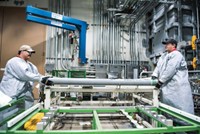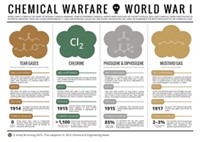Advertisement
Grab your lab coat. Let's get started
Welcome!
Welcome!
Create an account below to get 6 C&EN articles per month, receive newsletters and more - all free.
It seems this is your first time logging in online. Please enter the following information to continue.
As an ACS member you automatically get access to this site. All we need is few more details to create your reading experience.
Not you? Sign in with a different account.
Not you? Sign in with a different account.
ERROR 1
ERROR 1
ERROR 2
ERROR 2
ERROR 2
ERROR 2
ERROR 2
Password and Confirm password must match.
If you have an ACS member number, please enter it here so we can link this account to your membership. (optional)
ERROR 2
ACS values your privacy. By submitting your information, you are gaining access to C&EN and subscribing to our weekly newsletter. We use the information you provide to make your reading experience better, and we will never sell your data to third party members.
Policy
Evidence Of Syrian Chemical Weapons Use Mounts
International: White House says more proof is needed before taking action, calls for UN investigation
by Glenn Hess
April 26, 2013
U.S. intelligence officials believe “with varying degrees of confidence” that Syria has used chemical weapons against rebel forces in the country’s two-year-old civil war, the White House wrote in a letter sent to Congress yesterday.
White House officials say Syrian President Bashar al-Assad has used the nerve agent sarin, on the basis of results of “physiological samples.” But they caution that there is still a need to “establish all the facts” before the U.S. government decides how to proceed.
President Barack Obama has said the use of chemical weapons would be a “game changer” in the U.S. position on intervening in the conflict in Syria. Last August, he declared that “a red line for us” would be the movement or use of chemical weapons, adding “that would change my calculus.”
Now, “Our intelligence community does assess with varying degrees of confidence that the Syrian regime has used chemical weapons on a small scale in Syria, specifically the chemical agent sarin,” the White House says in a letter to Senate Armed Services Committee Chairman Sen. Carl Levin (D-Mich.) and committee member Sen. John McCain III (R-Ariz.).
“We do believe that any use of chemical weapons in Syria would very likely have originated with the Assad regime,” the Administration writes. “Thus far, we believe that the Assad regime maintains custody of these weapons and has demonstrated a willingness to escalate its horrific use of violence against the Syrian people.”
The Administration is also calling for a full-scale United Nations investigation into what may have happened.
“Given the stakes involved, and what we have learned from our own recent experience, intelligence assessments alone are not sufficient—only credible and corroborated facts that provide us with some degree of certainty will guide our decision making,” the letter states.
McCain’s response is for the White House to escalate its involvement in Syria. Of Obama’s line in the sand, “I think it’s pretty obvious that red line has been crossed,” McCain says.
He wants the Administration to create a safe zone for the Syrian opposition, establish a no-fly zone, arm vetted rebel groups, and take action to secure chemical weapons stocks.
Sen. Dianne Feinstein (D-Calif.), chairwoman of the Senate Intelligence Committee, says Syria possesses a “significant stockpile of chemical weapons” and has the ability “to kill tens of thousands” of people with those weapons.
But Feinstein also says the U.S. should not act alone. Instead, she wants the UN Security Council to “finally take strong and meaningful action to end this crisis in Syria.”
Without a strong international response, Feinstein is concerned that Assad might step up his attacks on the Syrian opposition. “It is also important that the world understands that the use of weapons of mass destruction, such as sarin, will not be countenanced, and clearly Assad must go,” she says.
Syria is one of only eight nations in the world that have not joined the 1997 Chemical Weapons Convention, an international treaty that prohibits the production, stockpiling, or use of chemical weapons. Six countries have not yet signed or ratified the convention—Angola, Egypt, North Korea, Somalia, South Sudan, and Syria; two countries, Israel and Myanmar, signed but have not yet ratified the accord.
Sarin, a potent organophosphorus nerve agent, was used in a terrorist attack in Japan in 1995 and possibly during the Iran-Iraq War in the 1980s, according to the U.S. Centers for Disease Control & Prevention. In large doses, the gas can cause convulsions, paralysis, and death.




Join the conversation
Contact the reporter
Submit a Letter to the Editor for publication
Engage with us on Twitter